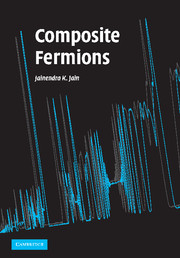Book contents
- Frontmatter
- Contents
- Preface
- List of symbols and abbreviations
- 1 Overview
- 2 Quantum Hall effect
- 3 Landau levels
- 4 Theory of the IQHE
- 5 Foundations of the composite fermion theory
- 6 Microscopic verifications
- 7 Theory of the FQHE
- 8 Incompressible ground states and their excitations
- 9 Topology and quantizations
- 10 Composite fermion Fermi sea
- 11 Composite fermions with spin
- 12 Non-composite fermion approaches
- 13 Bilayer FQHE
- 14 Edge physics
- 15 Composite fermion crystals
- Appendixes
- References
- Index
15 - Composite fermion crystals
Published online by Cambridge University Press: 07 December 2009
- Frontmatter
- Contents
- Preface
- List of symbols and abbreviations
- 1 Overview
- 2 Quantum Hall effect
- 3 Landau levels
- 4 Theory of the IQHE
- 5 Foundations of the composite fermion theory
- 6 Microscopic verifications
- 7 Theory of the FQHE
- 8 Incompressible ground states and their excitations
- 9 Topology and quantizations
- 10 Composite fermion Fermi sea
- 11 Composite fermions with spin
- 12 Non-composite fermion approaches
- 13 Bilayer FQHE
- 14 Edge physics
- 15 Composite fermion crystals
- Appendixes
- References
- Index
Summary
The FQHE was discovered when Tsui, Stormer, and Gossard were looking for the Wigner crystal (WC), i.e. a crystal of electrons. While electrons in the lowest Landau level are now known to form a CF fluid at relatively large fillings, a solid phase is expected at sufficiently small fillings, when electrons are so far from each other that the system behaves more or less classically. This chapter is concerned with the nature of the solid phase. Theory makes a compelling case that the actual solid is not an ordinary, classical Wigner crystal of electrons, but a more complex, topological quantum crystal of composite fermions, in which quantized vortices are bound to electrons. This is called the “CF crystal,” to be differentiated from the electronic Wigner crystal. Experiments have seen indications of the formation of a crystal at low fillings, but further work will be required to ascertain its quantum mechanical character. (The quantum mechanical behavior of 3He and 4He solids has been studied extensively. Quantum mechanics plays a fundamental role in the superfluid behavior of 4He solid, a subject of much current investigation.)
We also briefly mention the possibility of charge density wave states of composite fermions, for example, unidirectional stripes or bubble crystals, which have been proposed theoretically. These have also not been observed yet, but might occur in higher Λ levels (i.e., between regular FQHE states), and are analogous to similar structures believed to occur for electrons in higher Landau levels.
- Type
- Chapter
- Information
- Composite Fermions , pp. 442 - 457Publisher: Cambridge University PressPrint publication year: 2007



